Securing your emails is as crucial as your conversations and personal data. In fact, emails often include much more information about you. That’s why services like Tutanota Secure Email are gaining traction.
Especially, after Edward Snowden’s revelations about NSA’s surveillance program, the need to protect your privacy became the need of time.
Hence, Tutanota emerged as a secure email service that provides end-to-end encryption to the users. That, too, without any mandatory cost. Though, you can opt for their paid program to avail additional benefits.
Despite being an excellent service, and since it has been around for several years, Tutanota hasn’t created any hype in the internet world. Perhaps, you may not find any other Tutanota review explaining in detail about how to use it.
Nonetheless, as we strive to provide you with all the excellent privacy stuff, we share a detailed Tutanota guide for all first-time users.
What is Tutanota email?
Before getting your hands on the email service, let’s quickly review what Tutanota is all about.
Tutanota is a dedicated email service like traditional Gmail, Yahoo, and other providers. But what makes it different from others is its inherent security.
The name of the service itself is enough to hint at what it is. Derived from two Latin words – ‘tuta’ and ‘nota,’ which means ‘secure message,’ the name clearly shows that Tutanota is all about protecting your messages.
The service started off back in 2011 when the German firm Tutao GmbH launched it. Over the years, it established itself as a trusted app available as open-source. Hence, anyone can take a look at its code on GitHub to have insights about the service.
The service quickly gained traction among the users owing to its default end-to-end encryption. Just like a VPN encrypts all your network data, Tutanota encrypts all your emails. Thus, it saves your conversations from man-in-the-middle, spying, phishing, other cyberattacks, and surveillance by governments or ISPs.
What Makes Tutanota Distinct from Others?
If we talk about secure email services, then Tutanota isn’t the only one. There is fierce competition in the market, given that many usual email services also offer encryption. For instance, you can easily send encrypted messages via Gmail and Outlook, too.

Not to forget mentioning the rival ProtonMail that is used by many cybersecurity enthusiasts.
Nonetheless, Tutanota still manages to be in the lead owing to the following remarkable features.
Tutanota guide to email security – How to use it
All right, let’s wrap up the review and start with what you are here for – how to use Tutanota!
Signing-up
Well, before using Tutanota, you first have to create an account with the service. This will let you have a dedicated email address with a ‘tutanota.com’ domain.
1. Go to the service website (https://tutanota.com/) and click on the ‘SIGN UP’ button. A new tab will open in your web browser.
2. The new tab will first require you to choose a subscription plan. Since Tutanota has a freemium model, you can either choose the free package or go for either of the two paid plans.

The freemium model is for private users only. If you want to use Tutanota for your business, then click on the ‘Business’ tab. Here, you will find the paid subscription plans for businesses.

In the steps below, we will show you how to create an account for free. So, we’ll proceed with the ‘Private’ free plan.
3. Upon clicking the ‘Free’ option, you will see the following prompt. It’s because the service only allows one free account per customer at a time.

Click on ‘OK’ to proceed to the next step.
4. You will see the following video now, where you have to set up your email address and password. As mentioned, keep your password safe because you cannot reset it. Perhaps, you can use a good password manager here to handle this burden.

Check on the options shown at the end to agree with Terms of Service and confirm your age. The site is clearly meant for adult users (16 years and above). Hence, if you’re a minor, then we’re sorry, Tutanota isn’t for you.
5. The site will take a while to register your account, after which you will see another window showing a recovery code. Save this code somewhere with you because you will need it in case you have to reset your password.
Then, once you enter the CAPTCHA, you will land at the following screen.
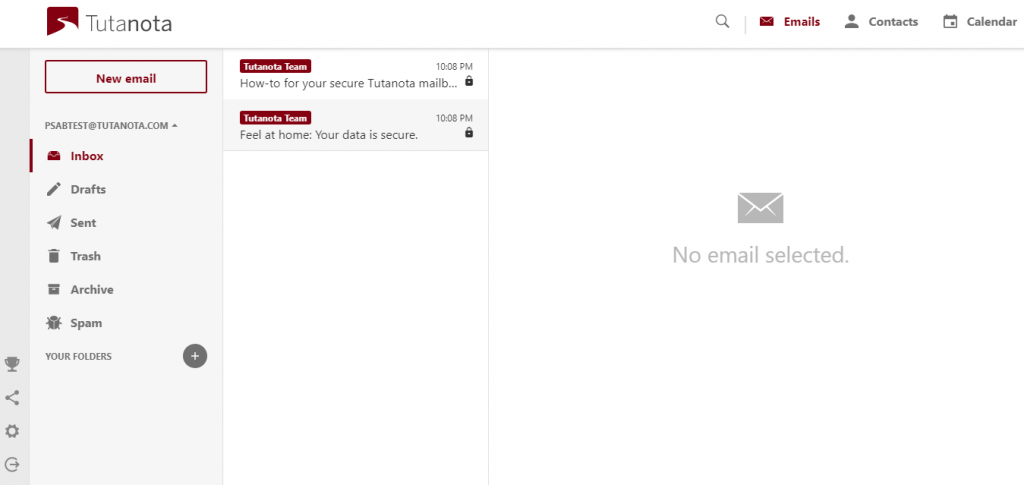
And here, you end the sign-up process. (Pretty simply, isn’t it?). You are now a Tutanota user.
Getting started
The overall Tutanota interface is pretty simple and interactive. It bears a simple color scheme and has clear-cut options. The right side of your screen shows the reading pane, the middle section has all the emails listed, whereas the left is the folder list bar.
On the top right, you will see clear options to view your emails, contacts, and the calendar. Note that the calendar is also end-to-end encrypted so that your events remain private to you.
Whereas, on the bottom left of your screen, you will find the options for upgrading to a premium plan, sharing about your Tutanota account with others, account settings, and log out (note the red marking).
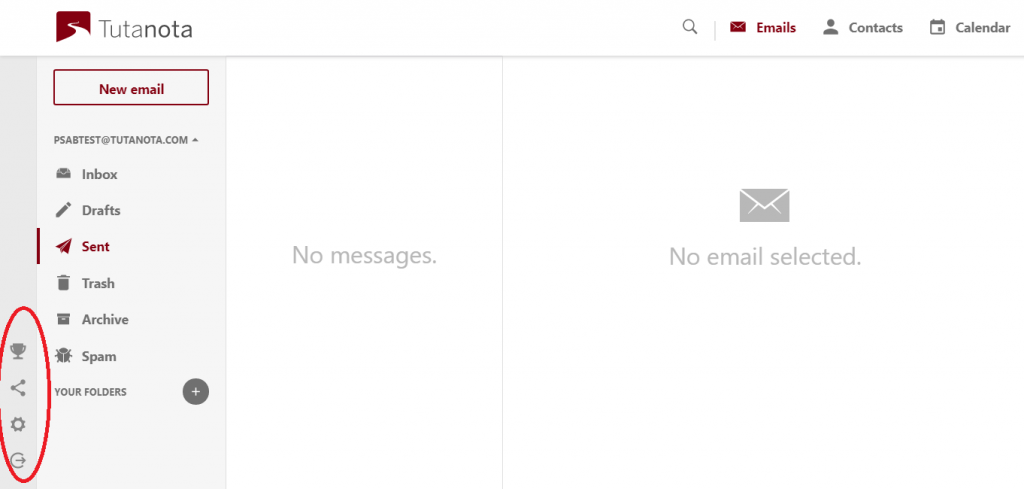
Now that you are used to the web interface of Tutanota Secure Email, let’s start with how you can send emails from your account.
In the following steps, we’ll be using the web version of the web. But you can undoubtedly download the Tutanota desktop client for your Windows, Linux, or Mac here. Likewise, you can also install the respective Android or iOS apps on your smartphones and tablets too.
Sending Tutanota to Tutanota emails
Sending emails to other Tutanota contacts is one of the easiest things to do. You don’ have to bother much about email security, as all internal emails are encrypted by default.
Moreover, this is an option with Tutanota to send email without password requirements with no compromise on security. When you join Tutanota, it’ll be great to invite your close contacts on this email service to enjoy safe communications.
Anyway, let’s take a look at how to send internal emails via Tutanota.
1. Simply click on the ‘New Email’ button to start your email. You will see the following window.

2. Just enter the respective Tutanota email address below the ‘To’ option. You can also add CC or Bcc by simply clicking on the ‘SHOW’ drop-down.
3. Enter the respective subject line for your email by clicking on the ‘Subject’ option.
4. Type your email in the textbox given below. You can either leave the Tutanota signature line as it is, or you can delete this sentence manually from the text.
5. Once done, click on the ‘Send’ option appearing on the top right.
Sending Tutanota emails to external clients
Tutanota isn’t meant to limit you to communicate with internal clients only. Instead, you can use it to communicate with external clients as well. In fact, this is the best-encrypted email service to make all your conversations secure wherever you are.
Just like Tutanota offers encryption to Tutanota clients, you can send encrypted emails to others too. Here’s how.
1. Click on the ‘New Email’ button and enter the respective email address of the recipient. When completed, a new bar will appear below the ‘To’ feature, where you can type a password. This password will be communicated to the recipient to open this email. In this way, your message remains protected from all prying eyes.

2. As you type the password, you will get an idea about the password strength via the grey bar appearing below.

3. After typing the password, you can now type the subject line and the email text in the respective sections.
4. If you want to change the email notification language, you can also do that by clicking on the ‘SHOW’ drop-down menu.

5. Once done, click on the ‘SEND’ option to send your email.
While Tutanota is great to send encrypted messages, with your Tutanota, send emails without a password to external clients as well. However, in this case, the emails won’t be encrypted.
You can simply opt for this feature by unchecking the red padlock icon on your email screen. The password feature will disappear, and your window will appear like this.

Managing your account
When you are using an online service, you need to know how to manage your account and profile settings.
In the case of Tutanota, the service provides various dedicated settings to let you choose how to send and receive emails.
You can find all the options by clicking on the gear icon at the bottom left of your screen. Here, the first option you will see will be your account settings. These include setting up your password, recovery code, and adding a two-factor authentication feature.
Also, scrolling down will show you the session history of the past two weeks. The service saves the information about the client and user IP address in encrypted form. Moreover, it deletes the session history after two weeks.
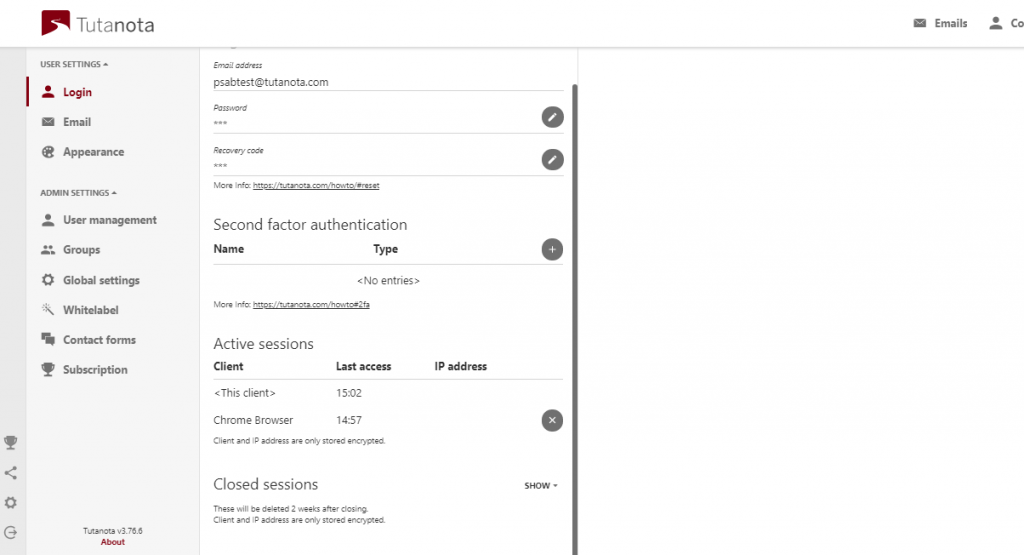
Managing email settings
Though, you may not have to meddle much with the account settings. Yet, you certainly need to learn about your email settings for a smooth experience in the future.
However, much of the settings here are only available to the paid users. For instance, if you want to apply rules to your inbox or add aliases, you need to subscribe to a paid package.
However, what you can still manage with a free Tutanota account is email encryption.
Just below your email account and sender name, you will see a feature ‘Default delivery.’ This is the feature that actually controls email encryption.
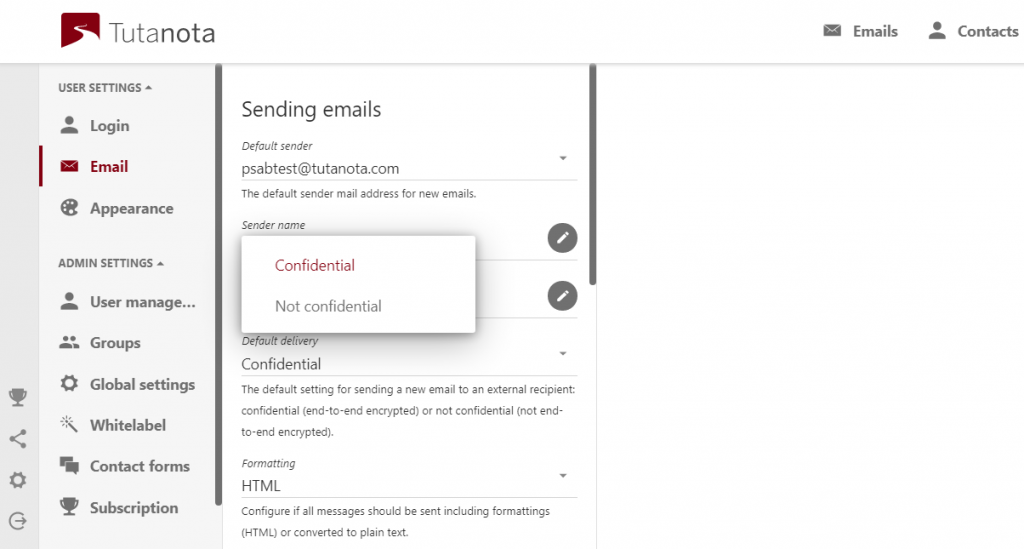
By default, it is set to ‘Confidential. It means every email you send to internal or external clients will be encrypted. As mentioned above, sending encrypted emails to external clients requires a password.
While you can turn off this feature individually before sending an email to an external client, you can also manage this feature through the given settings.
Simply set the default delivery status to ‘Not Confidential’. In this way, all external emails will be sent without end-to-end encryption in the future.
Though, the internal emails (Tutanota to Tutanota) will remain end-to-end encrypted.
Retrieving Tutanota block email
As Tutanota cares about user privacy, it not only offers encrypted messaging but also protects you from spams. Hence, it employs a robust security check on all incoming emails to filter out the malicious ones.
Such emails are not delivered to the users’ inbox. Rather Tutanota filters such emails and holds them onto their servers.
While the feature is good for privacy, it’s still possible that the service unintentionally blocks some emails vital to you.
Thus, it provides you with the settings ‘Rejected Emails’ that you will find in the ‘Global Settings’ menu.
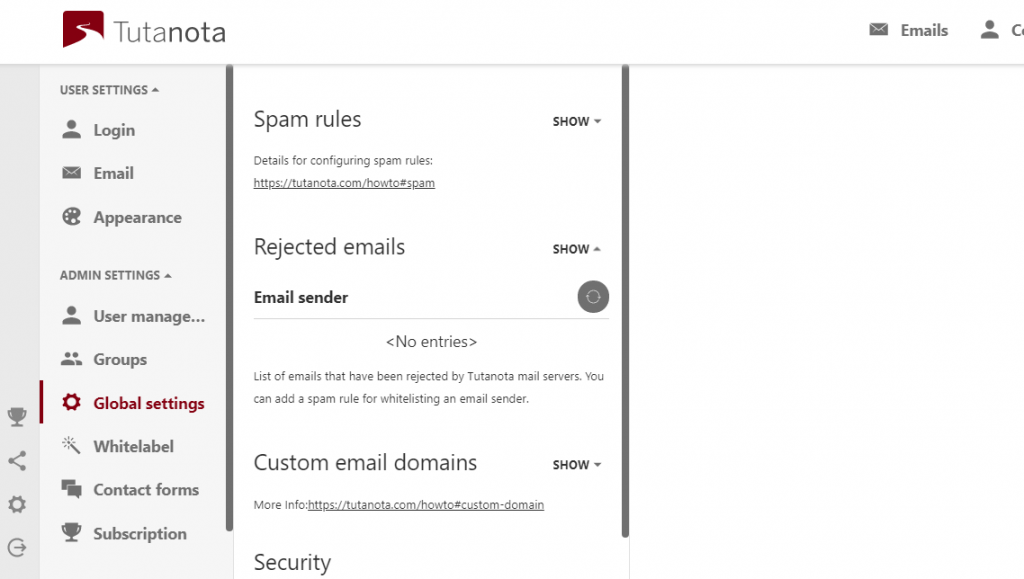
Here, clicking on this feature will let you check any Tutanota block email otherwise important to you. You can also whitelist the sender to receive future emails directly to your inbox.
Can I use Tutanota on Outlook?
Tutanota is a dedicated email service that offers end-to-end encryption within its own infrastructure. Hence, you cannot set up a Tutanota email on your Outlook app, because doing so will ruin the email encryption.
Also, you cannot adjust between Tutanota IMAP or POP3 settings, as it supports neither.
But it doesn’t mean that you are bound to use their web version. If you want to have Tutanota as your default ‘mailto’ client, you can download the Tutanota desktop client for it. Logging into the app will provide you with the same experience as you get with the web version alongside encryption.
How to delete a Tutanota account?
Though, Tutanota has the policy to delete free accounts that remain inactive for six months. Yet, if at any time you wish to stop using Tutanota, you can easily remove your account.
For this, you will find the ‘Delete Account’ at the bottom of the ‘Subscription’ menu.
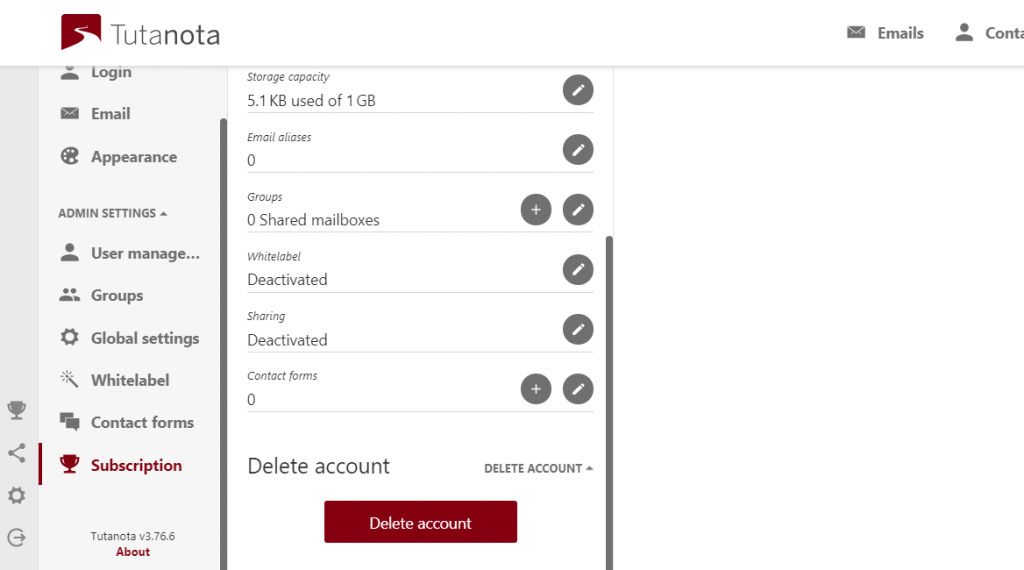
However, be careful before deleting an account as Tutanota won’t allow registration with the same email address again in the future.
Tutanota vs ProtonMail
Tutanota isn’t the only service that provides end-to-end encryption. Shortly after its arrival to the online world, another service, ‘ProtonMail,’ emerged in 2013.
This Swiss service also advocates for user privacy while offering end-to-end encryption and zero-knowledge working. This makes it a tough decision for an average user to decide which service to use.
So, below we draw a quick comparison of the two services.
Encryption protocol
While both Tutanota and ProtonMail offer end-to-end encryption, the difference lies in the protocols they implement.
ProtonMail implements AES, RSA, along with OpenPGP cryptography. Their cryptographic libraries are all open source. And, they apply symmetric end-to-end encryption. This encryption applies to the email texts. However, ProtonMail does not encrypt email subject lines. Hence, part of your emails remains visible.
Whereas, Tutanota employs a combination of symmetric and asymmetric algorithms. Precisely, it uses AES-128-bit and RSA 2048-bit. Whereas, in case of emails to external clients, it applies AES-128-bit symmetric encryption. In the case of Tutanota, encryption applies to the entire content of your emails, including subject lines.
Moreover, Tutanota also applies bcrypt and SHA-256 hashes for securing passwords.
Jurisdiction
ProntonMail is basically a Swiss service based in the neutral zone of Switzerland. That makes ProtonMail pretty much desirable for privacy freaks as the territory isn’t bound to any sides by laws.
Tutanota, however, is based in Germany – one of the 14 Eyes regions. Nonetheless, it leverages the strict EU GDPR that prohibit uninformed collection of personal information.
Email import
Tutanota clearly does not support importing emails. It clearly mentions about this on its website.
Here, ProtonMail wins as it does support the import of emails. Also, it encrypts all the messages right after import. Hence, your emails remain secure.
Email to external clients
Both Tutanota and ProtonMail let the users send emails to external clients, such as Gmail, Outlook, and others.
Also, both of them support sending these emails with password-protected end-to-end encryption. But the difference lies in the way this encryption applies.
In the case of ProtonMail, users can choose the “Encrypt for Outside” feature to send encrypted emails. Nonetheless, as the service doesn’t encrypt subject lines and senders’ email addresses, part of the data remains visible, even to the other service providers.
Whereas, Tutanota warrants thorough security as it offers end-to-end encryption by default with thorough protection using U2F.
Wrapping up
So, this was all about using Tutanota Secure Email.
Certainly, for every privacy savvy internet user, Tutanota is an excellent option to use as their default email client. The service not only offers great security features but also supports all major devices with dedicated apps.
Although, as compared to ProtonMail, Tutanota’s interface may not be as interactive. Nonetheless, it’s easy to use, has clear-cut options, and offers numerous basic security features even for free users.
We hope this quick guide will prove to be helpful for you to get started with Tutanota. Nonetheless, if you face any difficulty at any step while using the service, feel free to write to us.




